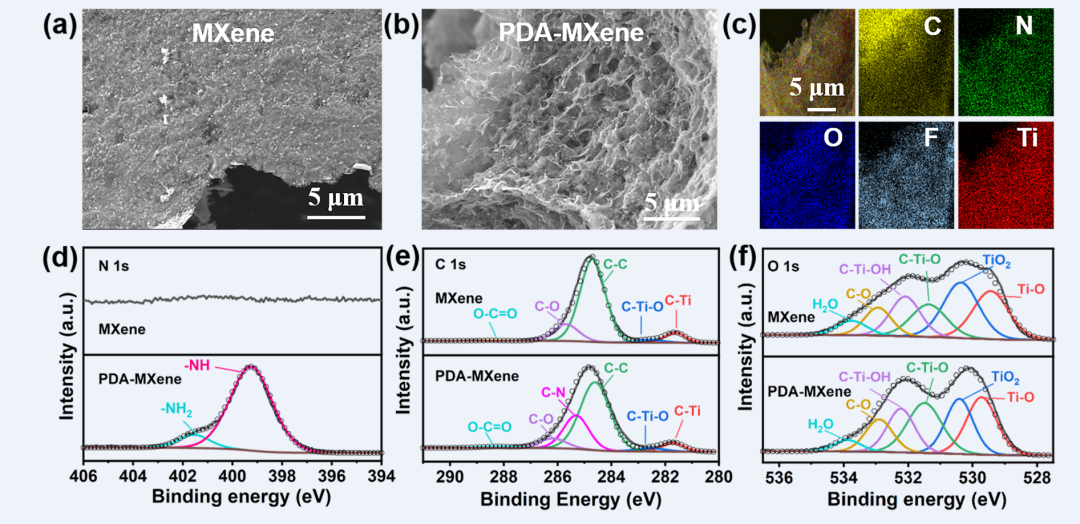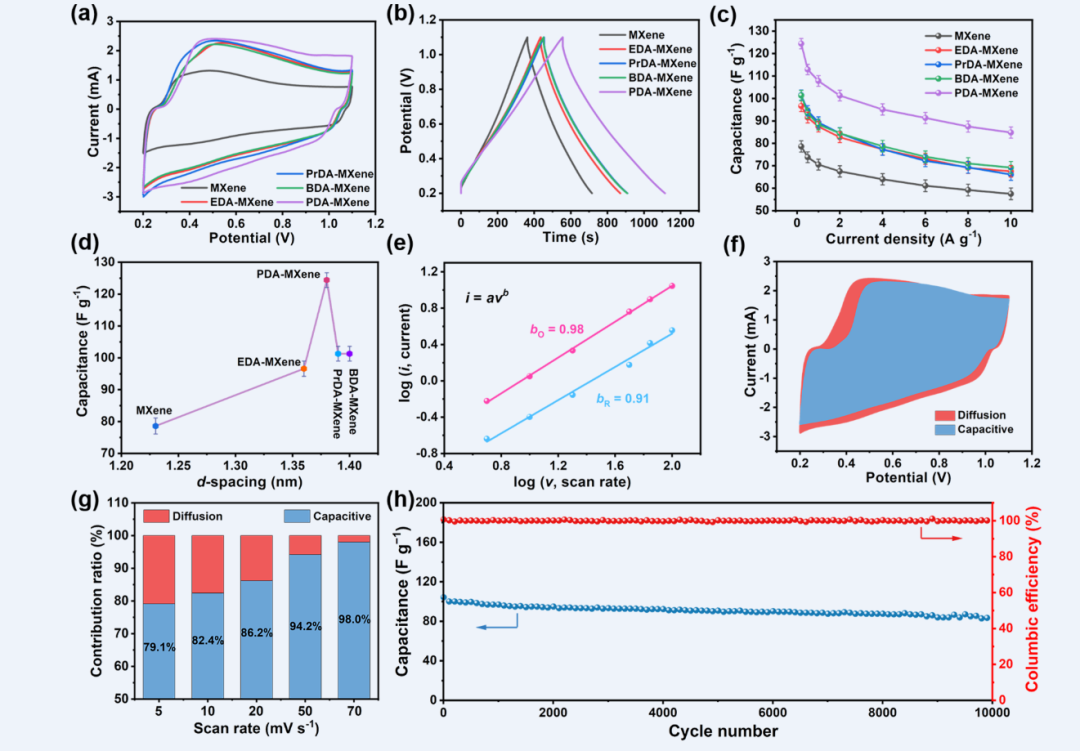Jiangxi Normal University, Professor Chen Yiwang of Nanchang University, Professor Yuan Kai AFM: Interlayer spacing regulation improves MXene stability and zinc ion storage capacity
QQ Academic Group: 1092348845
Detailed

Article information
Improvement of MXene Stability and Zinc Ion Storage Capacity by Interlayer Spacing
Research Background
MXenes are widely used as electrode materials for electrochemical energy storage due to their unique layered structure, excellent electrical conductivity, and surface hydrophilicity. However, similar to other 2D materials, the irreversible stacking of MXene flakes under van der Waals forces results in narrow interlayer spacing, loss of specific surface area, hindered ion transport, and reduced active sites, resulting in reduced electrochemical activity and inability to meet higher capacity of storage. Furthermore, MXene flakes are highly susceptible to oxidation, resulting in the loss of their 2D structural and functional properties.
Introduction to the article
Professor Chen Yiwang of Jiangxi Normal University/Nanchang University and Professor Yuan Kai of Nanchang University used aliphatic diamine and aromatic diamine molecules of different molecular sizes as pillars to insert between MXene layers to precisely control the interlayer spacing of MXene and increase the electrochemical active area, which significantly enhanced the The anti-oxidation and anti-stacking stability of MXene further enhances the interlayer charge transport capability and the Zn2+ ion storage capability in the zinc-ion hybrid supercapacitor, and the device has high capacity, good rate performance and cycle stability. Figure 1. MXene performance improvement and its applications.
main points of the article

Point 1: The macroscopic state change of MXene The synthesis of diamine intercalated MXene is shown in Fig. 2a. The surfaces of HCl- and LiF-etched MXenes are rich in end groups such as -F, -OH, and -O, which provide great possibilities for functionalizing MXenes with organic crosslinkers. Ethylenediamine (EDA), 1,3-propanediamine (PrDA), 1,4-butanediamine (BDA) and p-phenylenediamine (PDA) interact with oxygen-containing functional groups, intercalate and crosslink adjacent MXene flakes, promoting their self-assembly. The intercalated and cross-linked MXenes were in the gel state and turned into aerogels after freeze-drying treatment (Fig. 2b). Through the change of macroscopic state, it is proved that the diamine molecule enters the MXene interlayer and participates in the intercalation and cross-linking process.

Point 2: Characterization of MXene Micromorphology Pure MXene has a typical two-dimensional layered structure and smooth surface (Figure 3a). After PDA treatment, the surface of PDA-MXene is wrinkled and presents a three-dimensional porous structure, which is the cross-linking of PDA molecules on the surface of MXene. results (Fig. 3b). This wrinkled and three-dimensional structure is beneficial to avoid close packing of MXenes. In addition, the EDS spectrum of PDA-MXene showed uniform distribution of C, N, O, F, and Ti elements (Fig. 3c), further confirming the uniform grafting of PDA molecules on the surface of MXene. The chemical states of MXene and PDA-MXene were analyzed by XPS. The PDA-intercalated MXene shows a prominent N peak. By comparing the N 1s high-resolution XPS spectra of pure MXene and PDA-MXene (Fig. 3d), it is demonstrated that PDA molecules are cross-linked between the MXene layers. The high-resolution N 1s spectrum of PDA-MXene can be fitted to two peaks at 399.3 eV and 401.6 eV, corresponding to the amide and amine groups, respectively. This result can be attributed to the reaction of the amine groups of the PDA molecules with the carbonyl groups on the MXene surface, and the cross-linking of the PDA molecules between the MXene layers was further confirmed by comparatively high-resolution C1s and O 1s spectra (Fig. 3e,f).

Figure 3. Comparison of SEM and XPS before and after p-phenylenediamine intercalation of MXene.
Point 3: The stability of MXene is improved. After the intercalation and crosslinking of diamine molecules, the anti-oxidation and anti-stacking stability of MXene is significantly improved. Under ambient conditions, the color of pure MXene became lighter after 14 days, while the color of PDA-intercalated MXene did not change significantly. Combined with XRD (Fig. 4a), the (002) peak of pure MXene completely disappeared and the signal of TiO2 was detected. However, PDA-MXene maintains its prominent (002) peak around 6.6°, showing its excellent anti-oxidative and anti-stacking stability. From the microscopic morphology, the PDA-MXene retained the original wrinkled surface and 3D porous structure after 14 days under ambient conditions (Fig. 4c). However, pure MXene loses its typical surface-smooth 2D layered structure, but instead a particle-attached bulk structure, which can be attributed to the stacking and oxidation of MXene (Fig. 4b). High-resolution Ti 2p XPS spectra reveal the compositional changes of MXenes before and after 14 days of standing. For pure MXene, the atomic percentage of Ti-O 2p3/2 in all components increased significantly from 17.5% to 63% after 14 days at ambient conditions (Fig. 4d), indicating the oxidation of MXene to TiO2. The comparison found that the atomic percentage of Ti-O 2p3/2 changed little (from 24% to 31.3%) before and after PDA-MXene was placed for 14 days (Fig. 4e,f), indicating that PDA-MXene has good anti-oxidative stability, and XRD and SEM results are consistent. The improvement of anti-oxidation and anti-stacking stability is mainly due to the reducibility of amino groups and the supporting effect of diamine molecules.Figure 4. Comparison of stability before and after p-phenylenediamine intercalation of MXene.
Point four: MXene interlayer spacing regulation and specific surface area improvement The interlayer spacing of MXene was analyzed by XRD. Compared with pure MXene, the (002) peak of diamine-intercalated MXene shifts to a smaller angle (Fig. 5a), indicating that the interlayer spacing of MXene becomes wider. The interlayer spacing was calculated according to the Bragg equation (2dsinθ = nλ), and the interlayer spacings of EDA-MXene (1.36 nm), PrDA-MXene (1.39 nm), BDA-MXene (1.40 nm) and PDA-MXene (1.38 nm) were significantly higher than those of pure MXene (1.23 nm). The specific surface area and pore channel parameters are crucial to the electrochemical performance of the material. The N adsorption/desorption isotherms are shown in Fig. 5c. It can be intuitively seen that the specific surface area of diamine intercalated MXenes is significantly higher than that of pure MXenes. High specific surface area, suitable pore size distribution and large pore volume will enhance the efficient storage of charges. The effect of diamine molecular intercalation on MXene ion transport and charge storage is shown in Fig. 5e. In pure MXene, the narrow interlayer spacing and few active sites result in slow ion transport and less ion adsorption. In addition, the adsorbed ions occupy the ion transport path, leading to clogging of the channel and making ion transport more difficult. With the increase of the interlayer spacing and specific surface area of the diamine intercalated MXenes, the ion transport speed is accelerated, and the ion adsorption capacity increases. It has multiple transport pathways and ion adsorption sites, and ions can shuttle and adsorb between the three-dimensional cross-transport networks formed by the cross-linking of diamine molecules. Figure 5. Adjustment of interlayer spacing and improvement of specific surface area of MXene.

Point 5: Exploring the storage capacity of Zn2+ and comparing the electrochemical performance of zinc-ion hybrid supercapacitors (ZHSCs) assembled by MXene and its derivatives. Cyclic voltammetry (CV) and galvanostatic charge-discharge (GCD) test results (Fig. 6a,b) show that the diamine-intercalated MXenes as cathode ZHSCs have higher specific capacitance, verifying the enlarged interlayer spacing and specific surface area The improvement of MXene has a certain effect on the electrochemical performance of MXene. Figure 6d shows the relationship between the capacity of ZHSCs and the interlayer spacing of MXenes, indicating that the PDA-intercalated MXenes have a layer spacing more matched to the size of Zn2+ ions and a more suitable pore size distribution for improving the efficient storage of Zn2+ ions. The kinetics and energy storage mechanism of ZHSCs assembled with PDA-MXene as cathode were further investigated. In Figure 6e, the oxidation and reduction peak b values of PDA-MXene are 0.98 and 0.91, respectively, indicating its fast capacitance-dominated charge storage mechanism. The Dunn method was further applied to calculate the potential-dependent capacitance and diffusion-controlled contributions of PDA-MXene, demonstrating its charge storage dominated by capacitance and relatively fast kinetics (Fig. 6g). In addition, the Zn//PDA-MXene ZHSC exhibited good cycling stability, with a capacitance retention of 85% and a Coulombic efficiency close to 100% after 10,000 cycles at a current density of 1 A g-1 (Fig. 6h).

Figure 6. Exploration of Zn2+ storage capacity and application of Zn2+ capacitors.
This work proposes the synthesis of a series of intercalated MXene materials with precisely tunable interlayer spacing using aliphatic and aromatic diamines as pillars. Diamine-intercalated MXenes exhibit excellent anti-stacking and anti-oxidative stability due to their three-dimensional structure and the reducibility of amino groups. PDA-MXene exhibited better interlayer spacing matching (1.38 nm) and pore structure, improved the contact area between electrolyte and electrode, enhanced charge transport performance, and facilitated the storage of Zn2+ ions. The specific capacitance of Zn//PDA-MXene ZHSC at 0.2 A g-1 is as high as 124.4 F g-1, and it can still maintain 85% of the capacitance after 10,000 cycles at 1 A g-1. These findings of precisely tuning the interlayer spacing and improving stability provide important insights for the rational design and fabrication of MXene-based materials for electrochemical energy storage.Article link
Manipulating the Interlayer Spacing of 3D MXenes with Improved Stability and Zinc-Ion Storage CapabilityMengke Peng, Li Wang, Longbin Li, Xiannong Tang, Bingyu Huang, Ting Hu, Kai Yuan*, Yiwang Chen*https://onlinelibrary.wiley.com/ doi/10.1002/adfm.202109524
About the corresponding author
Professor Yuan Kai. Professor of Nanchang University, doctoral supervisor, double doctorate degree from Wuppertal University and Nanchang University in Germany. Mainly engaged in the design and synthesis of nano-energy materials and their application in energy conversion and storage systems, such as supercapacitors, metal-air batteries and fuel cells. He has published more than 50 academic papers in internationally renowned journals such as J. Am. Chem. Soc.; Angew. Chem. Int. Ed.; Adv. Mater.; Adv. Funct. Mater.; Energy Environ. Sci. He presided over the National Natural Science Foundation of China, the Science Fund for Distinguished Young Scholars of Jiangxi Province and other projects, and won the Postdoctoral Innovative Talent Support Program and the Young Jinggang Scholars Award Program.
Professor Chen Yiwang. Professor of Jiangxi Normal University/Nanchang University, doctoral supervisor, winner of the National Science Fund for Distinguished Young Scholars (2014), selected as the leading talent in science and technology innovation of the National “Ten Thousand Talents Program” (2016), and National Ten Thousand Talent Project (2017) , National Young and Middle-aged Scientific and Technological Innovation Leading Talents (2014), New Century Excellent Talents Program of the Ministry of Education (2006), German Humboldt Prize Scholars (1999), and enjoys special allowances from the State Council (2007). Presided over and completed the National Natural Science Foundation of China Key Project/Outstanding Youth Fund Project and other projects. Mainly engaged in research on nanocomposite of wearable polymer energy systems such as highly wear-resistant silicone elastomers, flexible solar cell design and printing, organic thermoelectric fibers, and supercapacitors. As the first author or corresponding author in Nat. Commun.; J. Am. Chem. Soc.; Angew. Chem. Int. Ed.; Adv. Mater.; Adv. Funct. Mater.; Energy Environ. Sci. More than 400 academic papers have been published in journals; more than 30 invention patents have been authorized, and 2 second prizes of natural science in Chinese universities.
- Previous: J. Energy Chem.|La-dop
- Next: MXene breakthrough: Na


 mxene academic
mxene academic